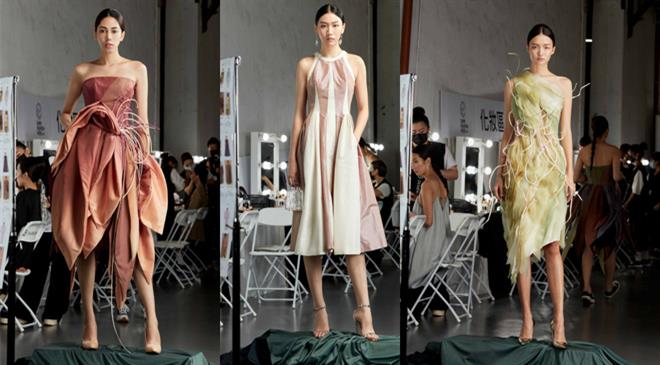Fashion designers have a key role to play in making fashion more sustainable
C JEAN is an independent designer brand founded by Chun-Yuan Jean. C JEAN’s designs explore stories of women and social issues, as well as contemporary art, architecture, and music. They are inspired by abstract metaphorical expressions of clothing and accessories. The contemporary contours and the Oriental introverted meticulous taste bring these issues to positive light through tailoring, structure, and colour. These designs make people reflect on issues and at the same time present unique brand traits. In an interview with Fibre2Fashion, the designer talks about her journey, fashion in her country and her thoughts on current fashion education.
Fibre2Fashion: How would you illustrate your journey in the world of fashion?
Chun-Yuan Jean:
Fashion design is a creative medium for me. I wanted to achieve something that makes real impact. I’ve worked for other brands in the past and I couldn’t have much idea or appropriation in the strategic direction of the brand back in those days. For instance, sustainable fashion, it’s not something that’s just popped up now, it’s something that I’ve always been exposed to when I was studying in London. I believe that C JEAN can gradually adjust its proportions and use more sustainable fabrics in the future, that’s our main target as well as the method we employ since beginning.
As a fashion designer, this on-going trend of so-called ‘fast fashion’ propelled designers to extend our grounds on which we stand and to reach out, because fundamentally we can never outrun it. As I recalled, my family would go to the tailor shop to have their clothes tailored, the material was really sophisticated back then, and only on New Year’s Day would we buy new clothes, and when the clothes were old, we would repair them with care. Nowadays, life has progressed, and everything is getting faster and faster. People are used to hoarding or throwing away things that are broken or obsolete. It becomes another trend that people refuse to cherish what they have. I understand that there is a huge gap between myself and people who are strictly environmentally friendly. I cannot say with a clear conscience that I have never been attracted to cheap clothing. That’s the reason why I am worried about this ongoing situation and the consumption habits that people have developed. The balance between dreams and reality is a big question for me always.
I think it’s very positive that in recent years people are becoming more conscious regarding the environmental issues. However, this change should not be the ultimate goal of sustainable fashion because true sustainable fashion for us is not just a ‘trend’, it should be seen as an ‘attitude to life’. With 73 per cent of millennials willing to pay more for sustainable products, according to the 2015 Nielsen Global Corporate Sustainability Report, there is clearly a strong business case for reducing the pressure on the planet, especially as consumer demand for green products increases, as does the demand for corporate transparency. As an emerging brand, the first priority for C JEAN is to embed sustainability awareness into our brand.
F2F: Where are you based and how would you describe fashion in your country?
CJ:
I am currently living in my country, Taipei, Taiwan. In Taiwan, the textile industry was an important economic driver around the 1970s. In recent decades, it has successfully transformed itself from a low-tech, high-volume traditional textile industry to a high-tech, high-performance functional/environmental textile industry, exporting 70 per cent of the world’s functional fabrics and even becoming a favourite supplier of eco-yarn jerseys to the World Cup tournaments.
Taiwan’s textile industry has spared no effort in sustainable innovation. To tackle the nine million tonnes of marine waste plastic each year, the marine environmental organisation Parley for the Oceans has partnered with Adidas and approached Taiwan’s Far East New Century to turn marine waste into shoe material, which has attracted a lot of attention.
Taiwan has never had a fashion week of its own until 2018 when the Ministry of Culture began organising the nation-wide Taipei Fashion Week, with three spring/summer (SS) fashion weeks in 2018, 2019 and 2020. Starting in 2021, Taipei Fashion Week is being held twice a year, in line with the international fashion weeks. The Taipei Fashion Week 2021 AW21 is the first Autumn/Winter fashion week in Taipei. In addition, it also announced the first fashion show in Asia to focus on ‘sustainable fashion’, linking the local textile industry to fashion designers, and continuing to begin a new chapter in Taiwanese fashion via close integration of the upstream, midstream and downstream industries.
F2F: Where do you get your creative nutrition? What fashion do you follow?
CJ:
The nature is always the best teacher. I love nature. Whether it’s the ocean, the earth, birds, insects, etc, I am amazed by everything in nature. Nature has all sorts of shapes and forms, like a huge database of colours and details. The subtle stimulation of the senses is an accumulation of energy. I also like to go to the seaside, where the endless skyline can give me relief from worries. The sea always has a magical power, as if it can swallow up all the unpleasantness. I think these natural sounds have a calming effect on my design thinking.
I think being curious about the world is a key to gain inspiration, and films often provoke people to think. It is like a poet who transformed the word into images, capturing the scene through deep involvement and the resonance that arises. The natural forms and colours bring out the harmony between man and nature in the design, and also give the design a unique artistic thought. I also love imaginative sci-fi films such as Inception, where I construct a dream that I am experiencing simultaneously. Another thing that fascinates me is the concept of time distortion, but I think what makes a good film compelling is the director’s ability to tell a convincing story. Not only does the director have to digest a huge amount of information in time, but he also has to give the decisive instructions and make the best choice at the right time. As a creator and artist, it is the director’s job to be creative and innovative. I think fashion designers and directors are actually very similar, so when I watch a film, I am also inspired.
F2F: The name of your overall collection is very soothing! Do you have any story or reason behind such names?
CJ:
C JEAN’s attention to global social and environmental issues is reflected on each season’s collection. The ‘Break’ series, which is designed to reflect the melting of highland glaciers due to the rising sea levels caused by global warming, the use of recycled wool to make flowers or rotting flowers to represent the melting of glaciers, or the use of splash jacquard to design exotic and colourful fabric flowers to represent the destruction of the oceans caused by human beings. The ‘Full Fathom Five’, where the destruction of the oceans has caused a qualitative change, or the ‘Lost Birds’, where the exploitation of habitats has left birds homeless and endangered species, are examples of how the diversity of ecosystems is an important factor in supporting us, but now we are losing biodiversity, which is an undeniable emerging environmental crisis.
In 2013, the Rana Plaza building in Bangladesh collapsed. The building housed a number of separate garment factories, and the building permit actually allowed for a four-story building. These workers were working for a number of well-known fast-fashion clothing brands. The collapse, which resulted in more than 3,000 casualties, drew attention to the cost of sweatshops in the fashion industry, including child labourers in garment factories who were merely paid $3 for 18 hours of work, and it was always the vulnerable workers at the bottom of the ladder who were sacrificed, leading to a greater focus on labour rights in the fashion industry in recent years.
In 2017, I went to Dongdaemun in South Korea with a friend to see what the wholesale market was like, which is full of business opportunities. The buying can go on until 7 or 8 a.m. and Dongdaemun is very busy in the early hours of the morning. There are people wholesaling, there are people stocking, and there are shopkeepers eating at 3 or 4 a.m., not knowing which meal they are having. Bags of clothes piled up on the curb waiting to be collected, delivery men and food vendors weaving in and out, neon lights lighting up the whole of Dongdaemun, thousands of clothes in black or green bags, some in huge piles. I felt like I was watching a film with a twisted kaleidoscope, which is named ‘Behind the Scene of Fast Fashion: A Documentary’.
C JEAN attempts to speak metaphorically about a serious issue, hoping to provoke the viewer’s attention to the environmental issues raised by the United Nations Environment Programme (UNEP) in a humane and touching way, rather than directly attacking (or jeopardising) the fashion industry. We will continue to respond to other issues, such as the impact of severe climate change and the relationship between water and land, through our work in the future.
F2F: How do you include sustainability in your fashion creations?
CJ:
Our theme of SS22 is ‘Eternity’, which is inspired by the American artist Georgia O’Keeffe’s ‘Morning Glory’. The video we showed at the London Fashion Week SS22 is shot through the different forms of glass, which reveal the creator’s imagination of the life and gesture of flowers.
The director of the Spring Pool Glass’ W Glass Project, Ting-An Wu and me were both educated in the UK, and we can relatively appreciate that the issue of sustainability has been raised and talked about for a long time. However, the idea of how to bring it to life in Taiwan or to be more aware of it, and what the brand itself can do about it, gave us the opportunity to work on the project. Ting-An has always been very supportive of the idea and even opened up the glass factory for us to do the film. We recreated this discarded glass into brooches, rings, necklaces and other accessories. During our attempts, there were problems with the coarseness of the blown glass, which led to breakage. The difficulty was that the time available for development was limited, so many further studies could only be done next time. However, we are happy that this time we have combined it with the garment and created a new imagination by matching the stamens and leaves on the garment. The garments are made from natural and recycled fibres, with multi-layered cutting and unique draping techniques, and are made in a couture style. The concept film was shot at the Spring Pool Glass factory, and director Shu-Han Chou also recreated the ‘life cycle of glass’ by washing, sorting and breaking discarded glass, echoing the meaning of the process of recycling, remanufacturing and remaking into a new life. The subtle curves and gradations of colour create a mysterious and life-affirming composition.
Collaborating with Spring Pool Glass - W Glass Project and inspired by the rebirth and the reuse of disposed glass, C JEAN 22 SS recreates the form of glass as a handicraft, combining it with its distinctive garments. This type of creation will not only demonstrate the value of ‘circular economy’ and ‘environmental symbiosis’, but will also express the endlessness of eternity between life and death via the different forms and energies of glass, as if our breath that flow and circulate incessantly, stretching or recessing. Eventually, the mystery of the cosmos will reside in a bud of flower, rendering each instant everlasting.
We also have collaborated with BENZ in an Earth Day project where we made doll-sized clothing from scraps and recycled fabric from ‘Movement In the Moment’. The collaboration with AUDI involved a launch of the fourth generation Audi A3 along with the concept of a fashion show, choosing casual and elegant clothing lines and using exotic materials to complement them. The details of the suit include the pressed folds, mimicking the streamlines of the car. Like Audi’s classic design of the car body on the lower edge of its window and the side folds above the threshold, the material and design of the car allow for the interplay of light and shadow to create a tight, vivid performance. These are designed to emphasise the slender silhouette of the car.
F2F: Is there anything you want to change in fashion education specifically?
CJ:
Fashion designers have a key role to play in making fashion more sustainable, as the designers are able to influence and contribute to all dimensions of fashion impact (not only economic, environmental, but social, cultural etc)—both positive and negative. Fashion design education should be seen as a chance to make aspiring designers aware of the challenges and potential of design for sustainability and equip them with the knowledge and skills necessary to implement sustainable fashion approaches.
I look forward to C JEAN becoming an influential brand. Although innovation in textile products often requires the use of chemical materials, and we should use appropriate chemicals, eco-textile has become an important trend in the future development of the textile industry, and this is an important consideration in our search for the right textile factory.
In addition to using natural and sustainable materials, at this stage we also collect rags, stockpiles and trimmings from textile factories, which we upcycle to make clothes and reduce the amount of fabric consumed. We also use graphics software to calculate and lay out the prints on the pattern and use sophisticated Mark Nesting techniques to minimise fabric consumption, thereby reducing fabric requirements. In addition to this, we try not to stockpile as much stock as possible, and we inject sustainability into the brand and the company’s daily life. Slowing down the pace of fashion and re-examining our consumption patterns will lead to environmental and ethical improvements in the global supply chain.
F2F: Brief about a few trending things in the fashion industry?
CJ:
Firstly, health and well-being is not only an important trend. For years, textile manufacturers and brands have been experimenting with the health-promoting properties of garments, for example by integrating nanocapsules to care for the skin and promote regeneration, or by acting as sensors, data conductors and power supplies for smart wires over large areas or to measure humidity, pressure points and temperature.
The COVID-19 pandemic has also brought focus on the anti-viral properties. Manufacturers such as Polygiene in Sweden and HeiQ in Switzerland have developed special finishes for textiles that kill viruses and bacteria, thus providing positive health protection. During the times of pandemics such as COVID-19, they can help people feel safer. Secondly, with a reduced carbon footprint, rental services and the rise of second-hand fashion, sustainability is a major trend in the fashion world. Until a few years ago, brands may have been able to position themselves as sustainable by using organic cotton, but today consumers have higher expectations and may want products that actually reduce their carbon footprint and are climate neutral. Increasingly, retailers, brands and consumers are moving away from making or buying new products and towards alternative consumption patterns. The second-hand market has been growing for many years. More and more brands and retailors are investing in new resale business models and offering second-hand goods alongside their regular collections – from The North Face and Vaude to H&M and Zalando. Finally, reducing resource consumption through the circular economy is already being seriously addressed by many brands, such as Swedish brand ‘On Running’ and its sneaker Cyclon, which provides customers subscription services, or the Norwegian Bergans’ partnership with Spinnova. But the number of product cycles that can be run or even just recycled products is still very small. This is mainly because the entire value chain up to the disposal plant must go hand-in-hand here. It is not enough to use only recycled materials in production; the finished product must also be recyclable at the end of its service life. However, the stronger and more durable the product, the more difficult it is to achieve the latter. Biological recycling, i.e., composting is also an option and is already being tested.





20230103183907.png)







_8.JPG)


